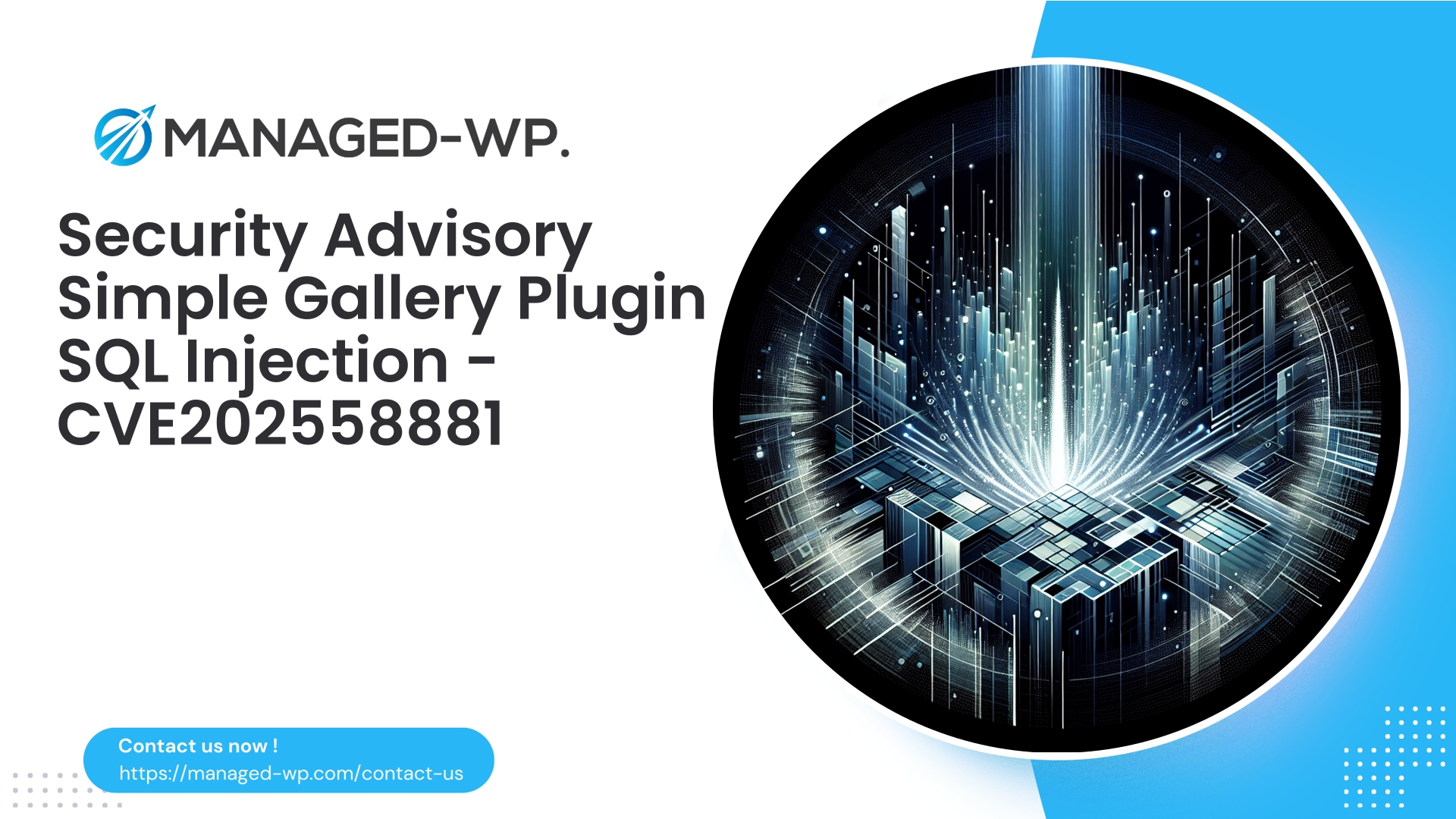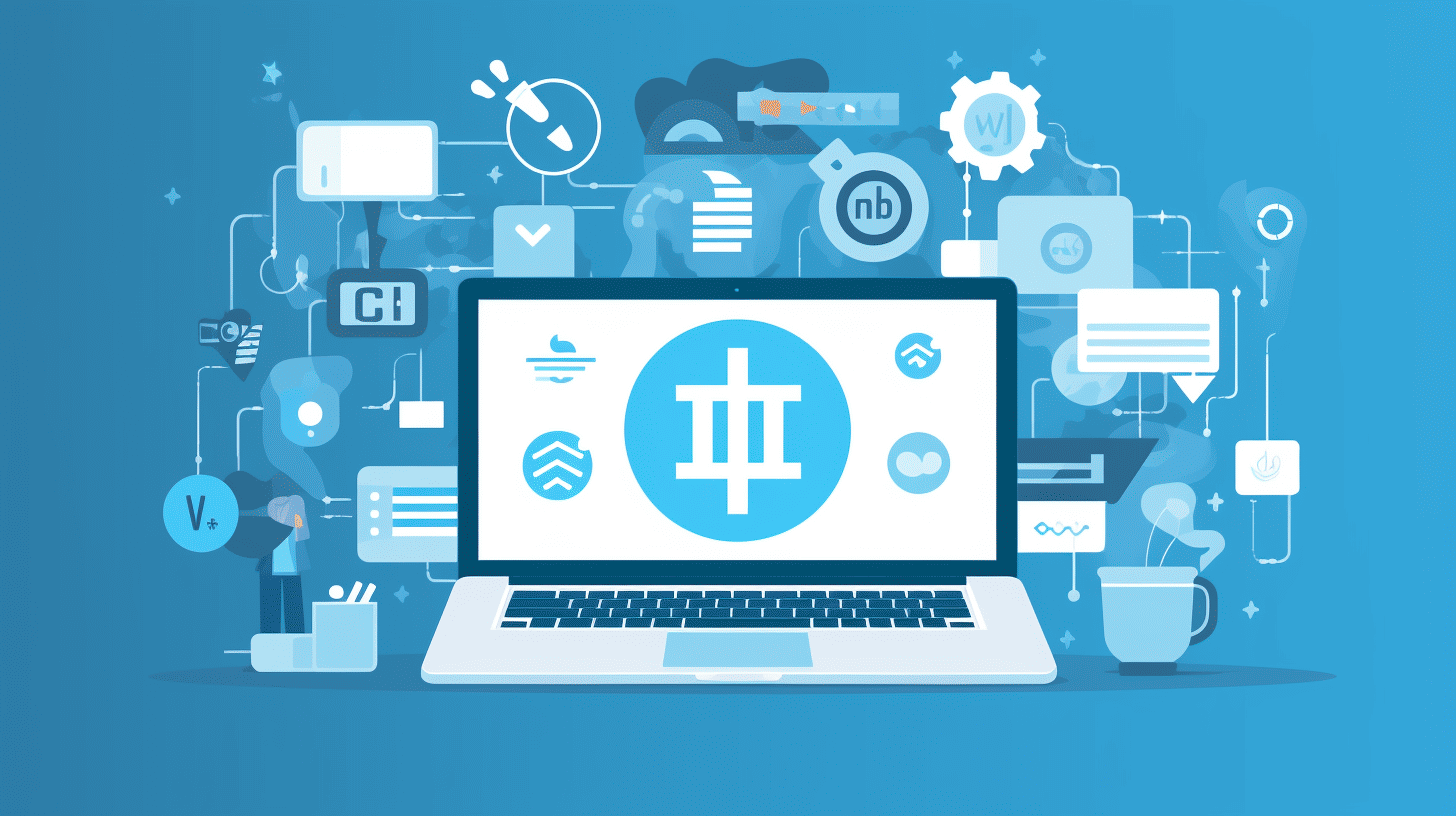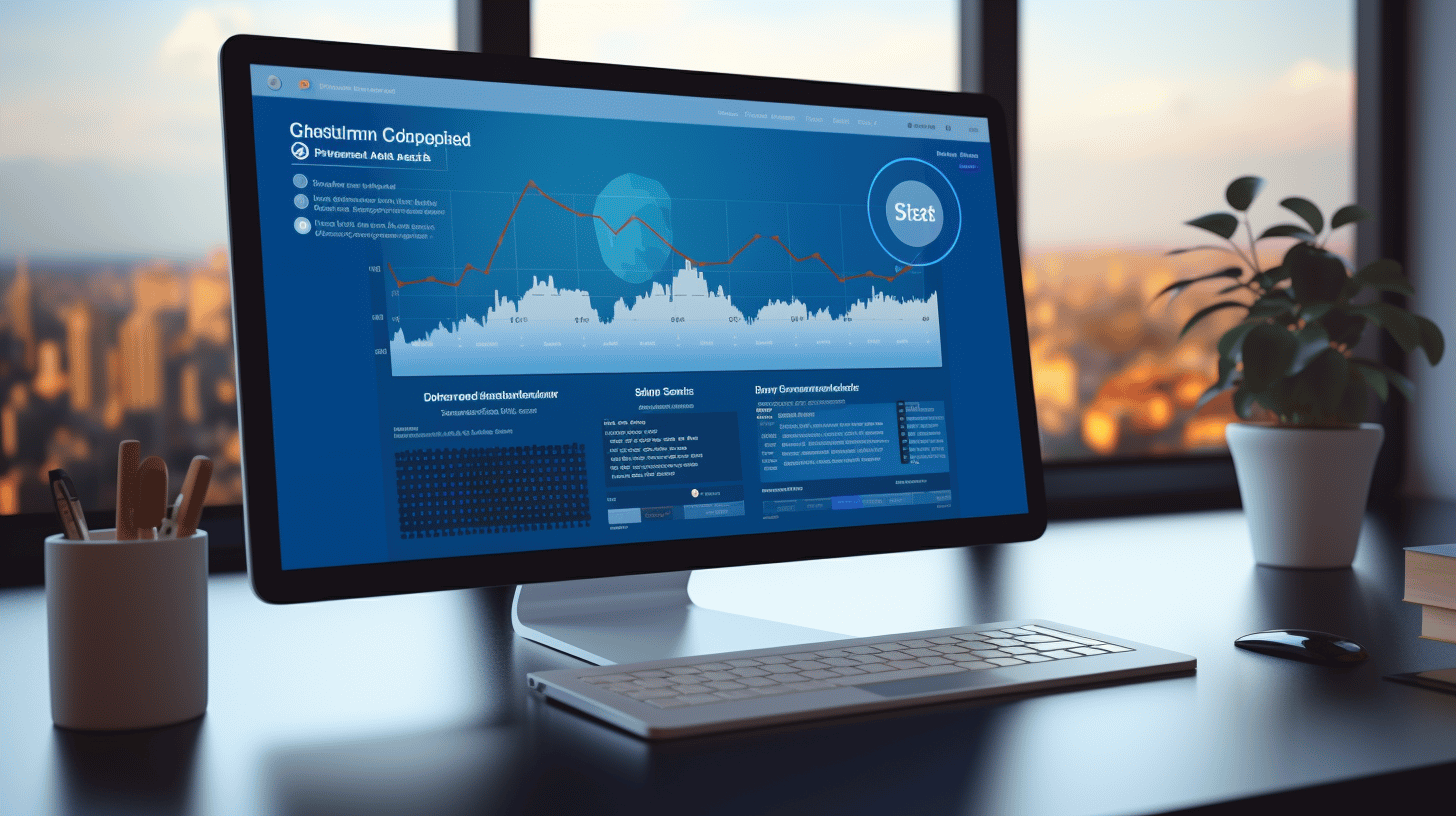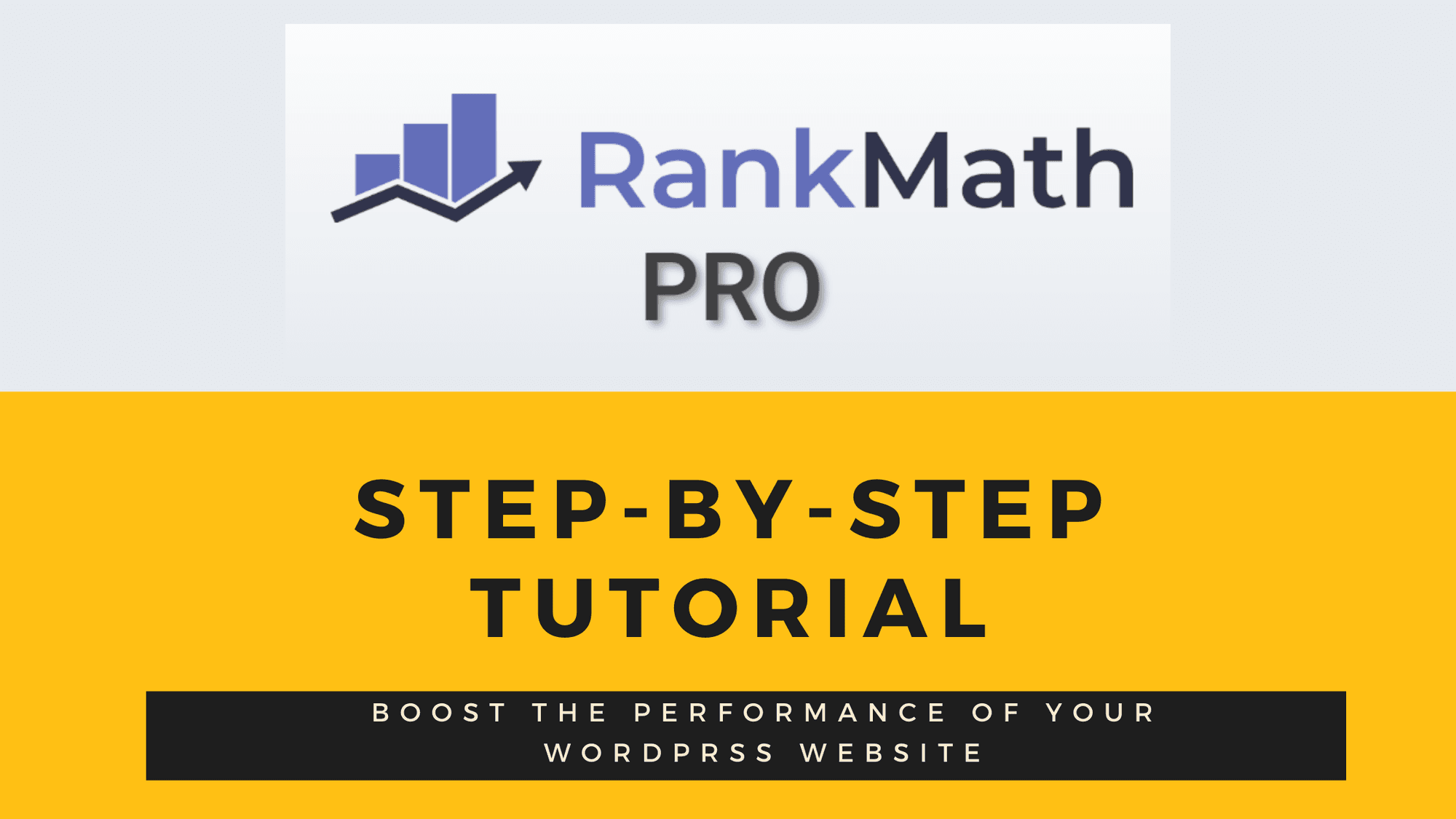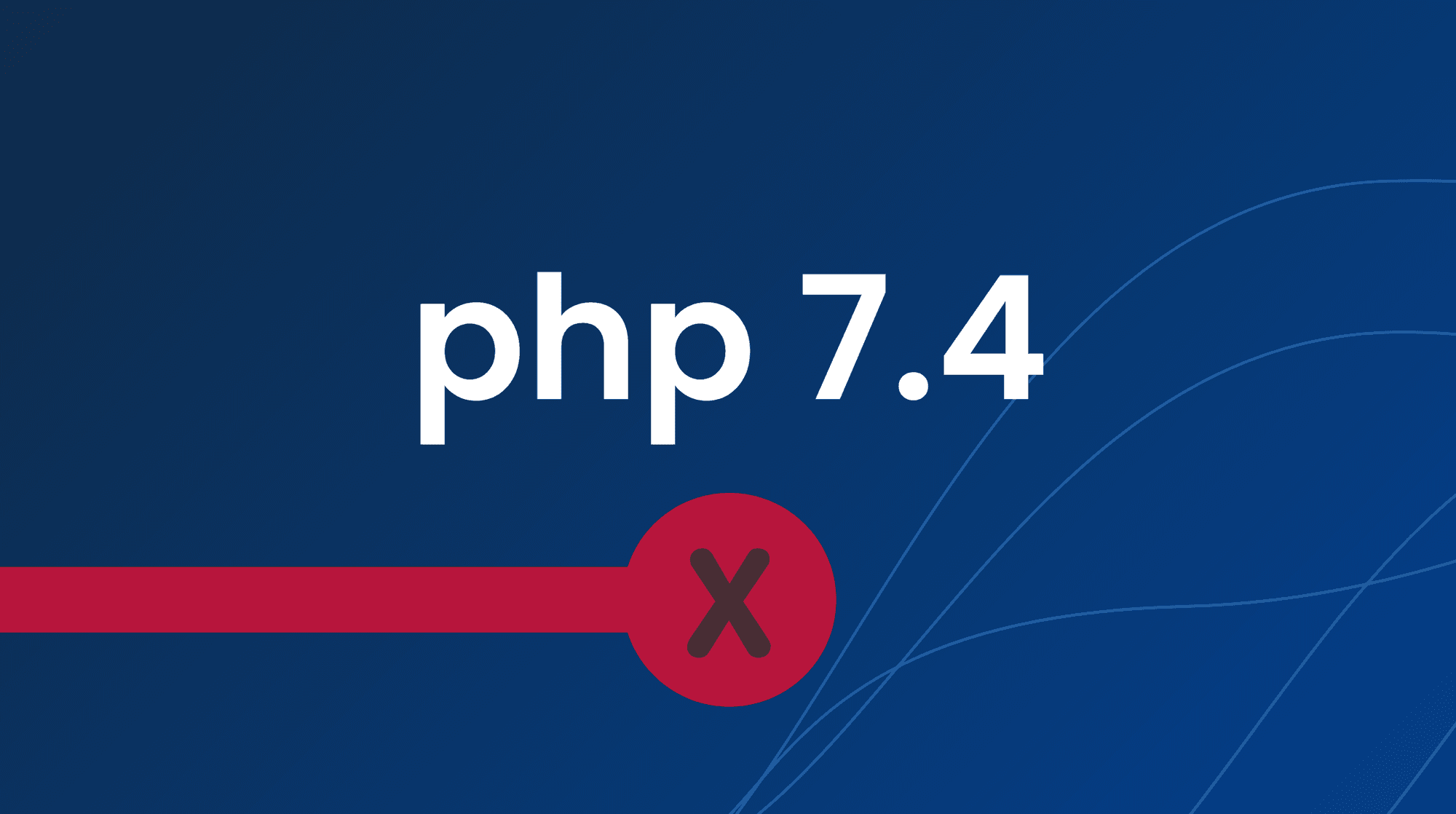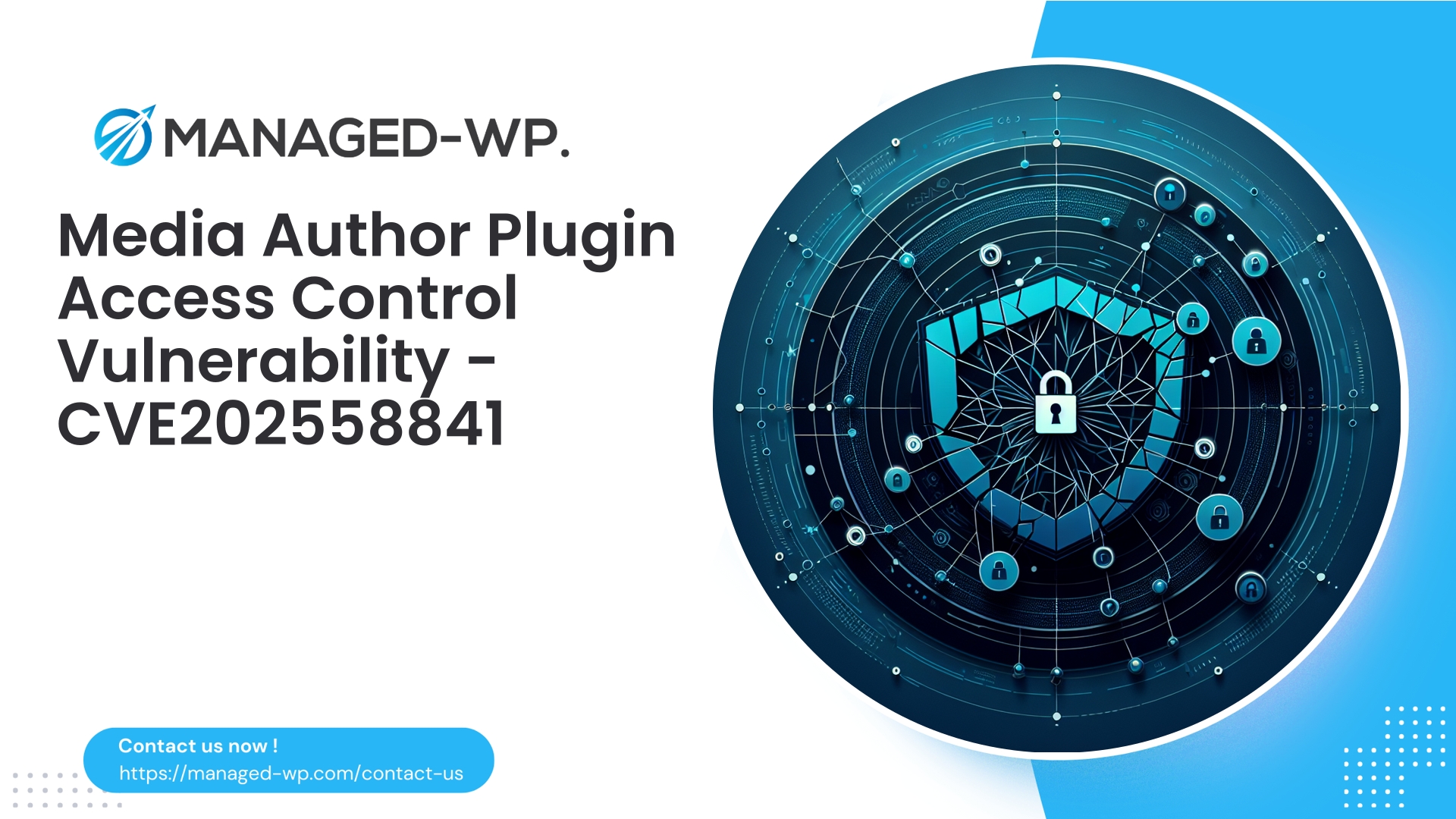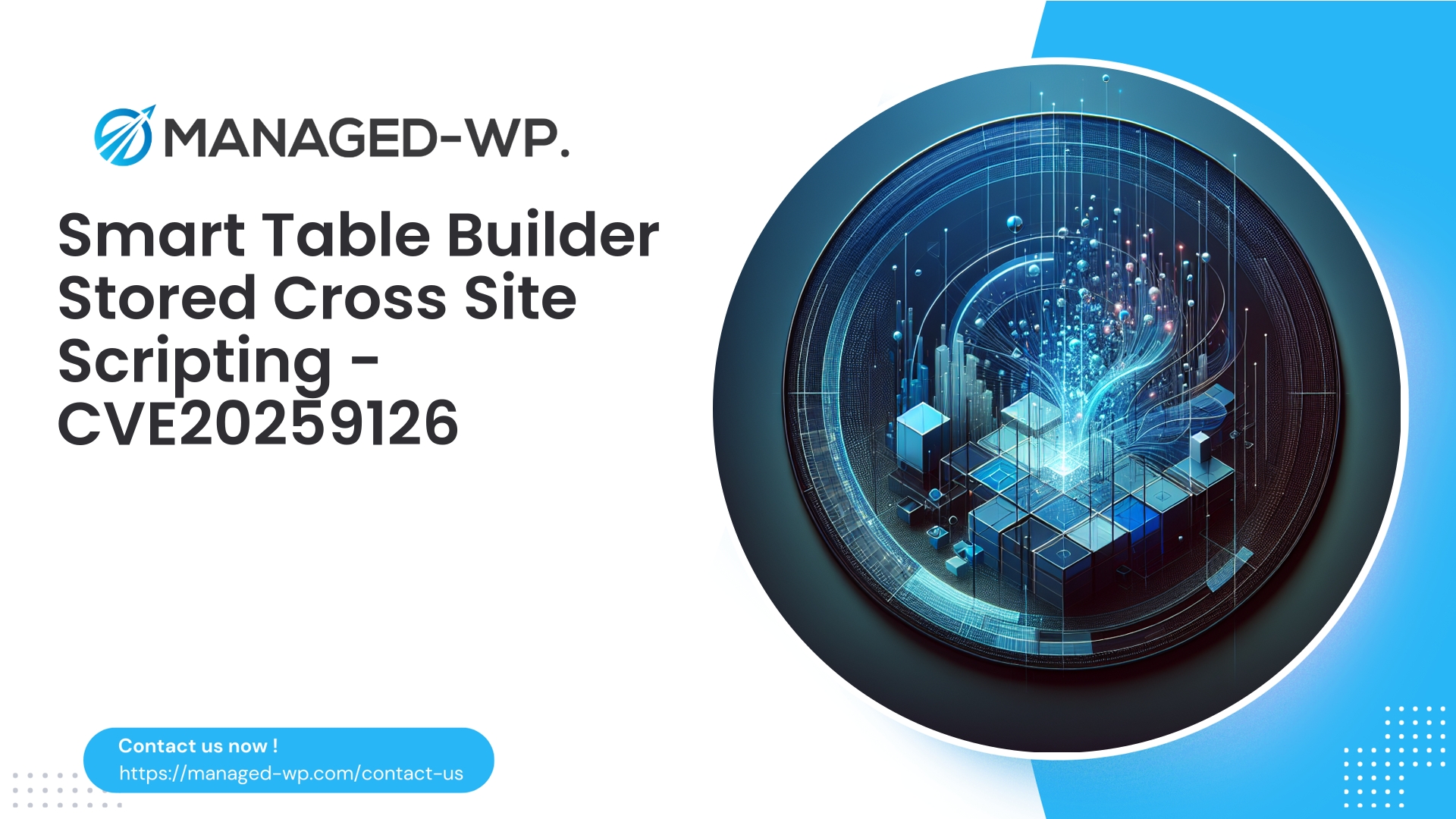| 插件名稱 | 新簡易畫廊 |
|---|---|
| 漏洞類型 | SQL注入 |
| CVE編號 | CVE-2025-58881 |
| 緊急 | 高的 |
| CVE 發布日期 | 2025-09-05 |
| 來源網址 | CVE-2025-58881 |
WordPress 新版簡易圖庫 <= 8.0 存在嚴重 SQL 注入漏洞 (CVE-2025-58881):網站所有者和開發者的重要指南
日期: 2025年9月5日
作者: 託管式 WordPress 安全專家
執行摘要
- 新版簡易圖庫 WordPress 外掛程式 8.0 及更低版本中存在一個嚴重的 SQL 注入漏洞 (CVE-2025-58881)。擁有貢獻者等級權限的使用者可以利用此漏洞。目前尚無官方補丁,且有跡象顯示該插件已停止維護。
- 雖然本文重點關注 New Simple Gallery,但這裡概述的緩解策略和安全原則廣泛適用於 WordPress 外掛程式和環境。
- 本簡報涵蓋了風險、立即緩解措施、開發人員建議、檢測技術,以及如何利用託管的 WP Web 應用程式防火牆 (WAF) 和虛擬修補程式提供臨時保護。
對於擁有多個使用者或第三方外掛程式的 WordPress 安裝的運營者,應仔細閱讀以下完整指南,以實施有效的補救和監控措施。
威脅情勢:為什麼 SQL 注入如此重要
SQL注入(SQLi)仍然是Web應用程式中最危險的漏洞之一,它允許攻擊者篡改後端資料庫查詢。新版Simple Gallery漏洞利用程式僅需貢獻者等級的存取權限即可發動SQL注入攻擊,這比典型的管理員等級漏洞更寬鬆:
- 能夠創建或修改內容的攻擊者(使用者角色:貢獻者)可以操縱嵌入在外掛程式中的不安全的 SQL 查詢。
- 這可能導致未經授權存取敏感數據,例如使用者憑證、網站配置和內容元數據,或惡意修改,包括植入後門。
- 由於沒有修補程式程序,而且該插件似乎已被棄用,網站仍然處於暴露狀態,掃描工具將越來越多地針對存在漏洞的安裝。
雖然安全公告可能由於存取權限要求而將此漏洞列為較低優先級,但擁有多個貢獻者或用戶註冊控制鬆懈的網站面臨中高風險。請根據您的特定運行環境評估威脅。
誰需要採取行動?
- 任何安裝了並啟動了 New Simple Gallery 8.0 或更早版本的 WordPress 網站。
- 允許建立貢獻者帳戶的網站—尤其是那些註冊開放或審核不嚴格的網站。
- 外掛程式已停用,但資料庫條目或計劃任務仍存在殘餘風險的網站。
立即行動計畫(下一小時內)
- 盤點您的風險敞口
- 找出您管理下所有執行存在漏洞版本的 New Simple Gallery 的 WordPress 網站。
- 審核各網站上的貢獻者等級帳號;了解誰可以發佈或編輯內容。
- 縮小攻擊面
- 盡可能暫時限制貢獻者的功能,降低其權限。
- 停用公開註冊或待使用者批准功能,以阻止未經授權的貢獻者建立。
- 如果無法立即刪除用戶,則應加強用戶審核機制。
- 插件停用
- 在安全的情況下停用「新簡易圖庫」;請注意,這可以減輕但不能完全消除插件先前儲存的資料或產生的排程任務的風險。
- 啟動託管 WAF/虛擬補丁
- 啟用或設定您的 WordPress 防火牆/WAF,以阻止針對此外掛端端點的 SQLi 攻擊模式。
- 如果沒有 WAF,則使用主機級保護或升級到提供虛擬修補程式的託管安全服務。
- 備份和包含
- 在進行進一步故障排除之前,請先建立網站檔案和資料庫的最新備份。
- 如果懷疑網站遭到入侵,請使用維護模式或 IP 允許清單隔離受影響的網站。
- 監測可疑活動
- 仔細檢查 wp_users 表中最近建立或修改的具有較高權限的帳戶。
- 調查可疑的定時任務、意外的外掛程式/主題以及修改過的資料庫選項。
中期補救措施(接下來的24-72小時)
- 插件替換: 鑑於缺乏支援和補丁,計劃過渡到提供類似功能的、積極維護的圖庫插件。
- 程式碼審核: 開發者應審核插件的原始程式碼,特別是是否存在不安全的 SQL 構造,並將動態查詢替換為預處理語句。
- 加強貢獻者權限: 實施需要審核的編輯工作流程,強制執行雙重認證 (2FA),並將權限限制在內容建立範圍內。
- 應用最小權限原則: 檢查所有使用者角色和 API 金鑰,確保其擁有最低限度的存取權限。
開發人員補救措施概述:防範 SQL 注入
SQL注入漏洞源自於SQL查詢中未經安全處理的輸入資料的不安全拼接。 WordPress開發者應遵循以下最佳實務:
- 利用
$wpdb->prepare()適用於所有包含使用者輸入的動態查詢。 - 優先選擇原生 WordPress 查詢 API,例如
WP_Query,get_posts(), 和WP_User_Query盡可能地。 - 嚴格驗證並清理所有參數,確保資料類型正確。
不安全範例(請勿使用):
$gallery_id = $_GET['gallery_id']; // 不受信任的輸入 $sql = "SELECT * FROM {$wpdb->prefix}galleries WHERE id = $gallery_id";
使用安全重構 $wpdb->prepare():
$gallery_id = isset($_GET['gallery_id']) ? intval($_GET['gallery_id']) : 0; $sql = $wpdb->prepare( "SELECT * FROM-14Tsql = $wpdb->prepare( "SELECT * FROM-14Tsql = $wpdb-> $gallery_id ); $results = $wpdb->get_results( $sql );
在處理要求之前,請務必驗證使用者權限,並對狀態變更要求實施 nonce 驗證。
推薦的WAF和虛擬補丁策略
Managed-WP建議部署有針對性的虛擬補丁規則,以最大限度地降低遷移或打補丁時的風險:
- SQL注入檢測: 阻止數值欄位中使用 SQL 關鍵字或元字元的可疑參數(例如,
ID,gallery_id). - Admin-AJAX 和 REST API 加固: 限製或驗證對敏感端點的存取。
- 貢獻者會話驗證: 對貢獻者發起的請求應用更嚴格的輸入驗證或重新身份驗證要求。
- 虛擬補丁簽名範例: 封鎖與外掛程式路徑相符的包含可疑 SQL 有效負載的請求(
聯合選擇,--等)在查詢參數中。 - 速率限制和異常檢測: 針對異常貢獻者行為和新帳戶創建以及可疑插件互動發出警報。
確保所有 WAF 規則都在測試網站上進行測試,以平衡安全性和正常功能。
需要關注的入侵指標 (IoC)
- 最近建立了意外的管理員或具有較高權限的帳戶。
- 資料庫中異常條目
wp_options或包含奇怪或序列化資料的自訂插件表。 - 未經授權的內容修改,包括注入腳本標籤。
- 插件端點出現大量錯誤或異常請求模式。
一旦發現可疑網站,應隔離並調查該網站,保留日誌和備份以供取證。
在預發布環境中進行安全測試
- 將生產環境完全克隆到測試環境,包括資料庫。
- 使用信譽良好的工具執行非破壞性漏洞掃描。
- 使用具有速率控制的定向模糊測試來發現 SQL 錯誤訊息。
- 驗證 WAF 規則,確保合法功能得以保留。
如果對測試方法有疑問,請諮詢安全專家。
事件回應檢查表
- 立即備份檔案系統和資料庫。
- 重置所有管理員和 API 憑證。
- 掃描惡意檔案、Web Shell 和意外的排程任務。
- 完成文件記錄後,刪除未經授權的管理員帳號。
- 從可信任來源重新安裝 WordPress 核心程式和外掛程式。
- 對權限進行嚴格控制
wp-config.php並輪換使用密鑰。 - 執行惡意軟體/EPP掃描器並進行人工檢查。
- 監控日誌,以發現持續性或重複性攻擊。
- 如果個人資料可能洩露,請遵循適用的法律和隱私協議。
長期安全措施
- 限制插件的使用,僅使用那些積極維護、支援良好且更新頻繁的插件。
- 維護準確的庫存和版本跟踪,以便及時發現漏洞。
- 嚴格執行角色和權限管理,最大限度地減少貢獻者和編輯者的權限。
- 要求所有具有內容修改權限的使用者啟用雙重認證(2FA)。
- 利用暫存環境和持續整合/持續部署 (CI/CD) 管道進行插件管理。
- 實施持續的自動化漏洞掃描和定期安全審查。
常見問題解答
Q:停用插件能保證安全嗎?
答:停用資料庫可以降低直接風險,但可能無法消除殘留資料庫記錄或計畫事件帶來的漏洞。仍需採取額外的清理和保護措施。
Q:我可以在本地為插件打補丁嗎?
答:技術團隊可以修補外掛程式原始碼中存在漏洞的 SQL 語句,但管理自訂修補程式會增加維護成本。從長遠來看,建議遷移到受支持的替代方案。
Q:如果我的網站沒有投稿人帳號怎麼辦?
答:利用漏洞需要貢獻者等級的存取權限,因此如果不存在此類帳戶且註冊功能已停用,風險將降至最低。但是,仍需保持警惕,因為可能存在其他攻擊途徑。
技術附錄:安全與不安全的 SQL 實踐
不安全範例(易受攻擊的連接語句):
$where = "WHERE name = '" . $_GET['name'] . "'";使用準備和消毒措施確保圖案安全:
$name = isset( $_GET['name'] ) ? sanitize_text_field( wp_unslash( $_GET['name'] ) ) : ''; $sql = $db->prepare( "STP4 FROMp %s", $name ); $rows = $wpdb->get_results( $sql );
使用未經清理的陣列不安全:
$ids = $_POST['ids']; // id 陣列 $sql = "SELECT * FROM table WHERE id IN (" . implode(',', $ids) . ")";
陣列的安全預處理語句模式:
$ids = array_map('intval', (array)$_POST['ids']); $placeholders = implode(',', array_fill(0, count($ids), '%d'));; IN ($placeholders)", $ids);
Managed-WP 如何保護您的 WordPress 環境
在 Managed-WP,我們的安全方法整合了多層防禦:
- 針對 WordPress 外掛程式進行精確調整的託管 WAF 規則,包括針對外掛程式特定端點和可疑輸入模式的虛擬修補程式。
- 角色感知啟發式方法對低權限使用者會話施加更嚴格的審查,從而限制貢獻者層級的攻擊面。
- 全面、無損的請求和回應日誌記錄,可在不擴大攻擊面的情況下加快事件取證速度。
- 當漏洞被揭露且上游修復程式不可用時,快速部署虛擬補丁,讓客戶有時間進行修補或遷移。
- 根據真實事件經驗制定的攻擊後清理指南和事件回應手冊。
如果您執行自己的 WAF,請驗證它是否包含針對 WordPress 上下文調整的插件端點特定的 SQLi 偵測,以避免過多的誤報,同時最大限度地提高保護。
立即獲得保護-從 Managed-WP 的免費安全計畫開始
我們的免費方案為您的 WordPress 網站提供基礎且必要的安全性保護,包括託管防火牆、惡意軟體掃描以及針對 OWASP 主要風險的緩解措施。對於可能受 New Simple Gallery 漏洞或類似風險影響的網站,Managed-WP 免費方案可在您制定修復計畫期間提供即時虛擬修補程式保護。
查看套餐並在此註冊: https://managed-wp.com/free-security-plan
方案選項:
- 自由的: 託管防火牆 + WAF、惡意軟體掃描和 OWASP Top 10 核心防護。
- 標準: 自動清除惡意軟體、IP位址封鎖/允許控制、增強型事件警報。
- 優點: 每月安全報告、自動虛擬修補程式和事件回應優先支援。
立即加入我們,透過久經考驗的安全措施來加強您的 WordPress 環境,同時實施長期修復方案。
站點車隊優先建議
- 在管理控制面板中審核並隔離已識別的易受攻擊網站。
- 立即部署針對性的 WAF 保護措施,以阻止 New Simple Gallery 攻擊路徑。
- 如果某個插件並非必不可少,則將其移除或替換。
- 在可行的情況下修補程式碼庫,並遷移到維護良好的插件替代方案週期。
- 透過日誌和WAF警報持續監控和事件偵測。
請記住:外掛程式維護和使用者角色管理是 WordPress 安全的關鍵組成部分。一個缺乏維護的插件可能會使您的整個環境面臨過大的風險。
如需協助掃描多個網站、配置 WordPress WAF 或進行事件回應,Managed-WP 的專家團隊隨時準備好協助您有效率且有效地保護您的網站。











